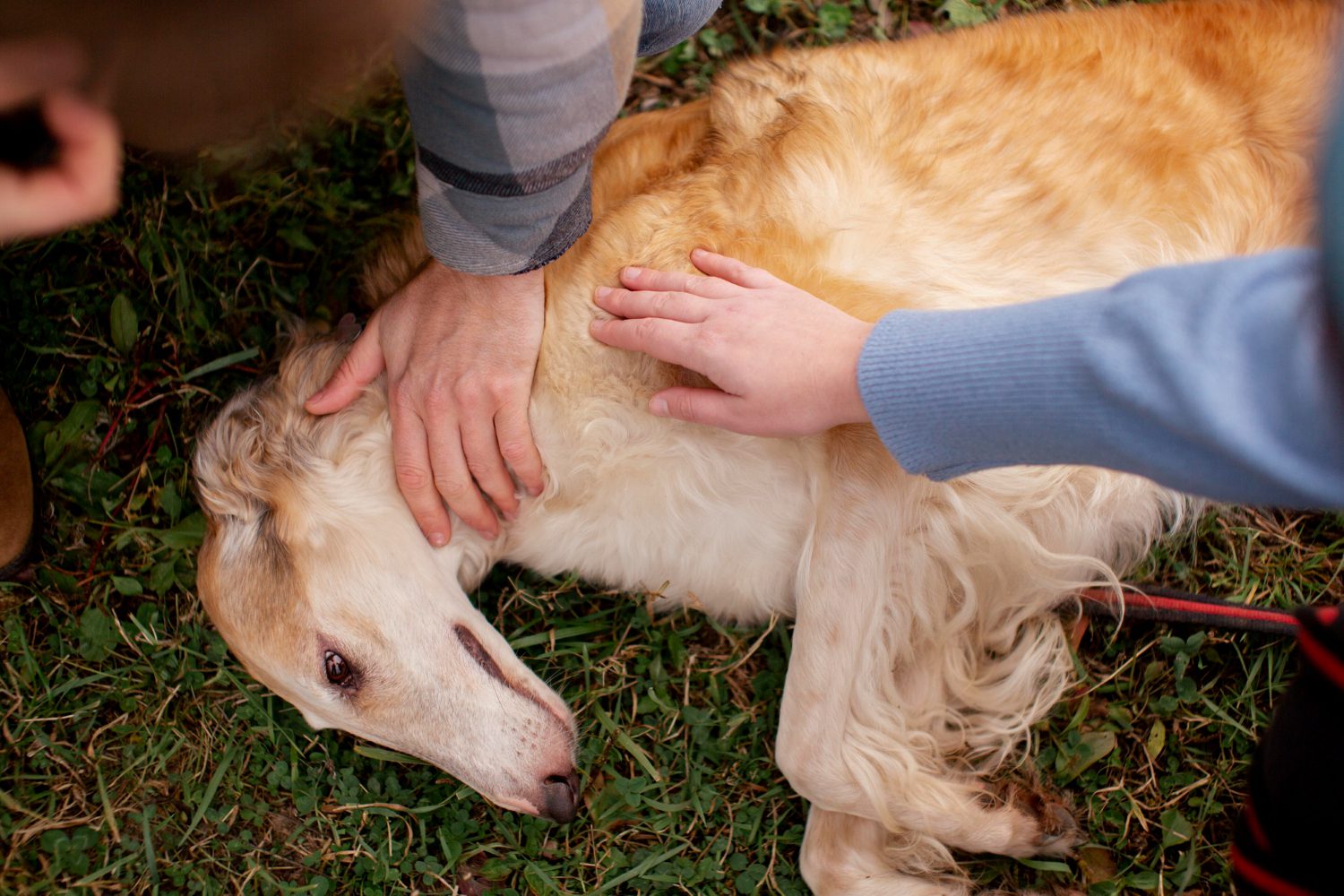What is HGE in Dogs?

By Evelyn Harcourt
September 02, 2025 - 1 min read
This non-infectious disease causes sudden vomiting and bloody diarrhoea in dogs. It is more often a disease seen in younger dogs, and patients can become critically unwell very quickly. This condition has the potential to be life-threatening due to the rapid fluid loss experienced.
In this article, you’ll learn about the presenting symptoms of HGE, the various causes, how diagnosis is made, and the best treatment options. We also explore what you can do to help prevent HGE in your furry friend.

What is HGE in Dogs?
HGE or Hemorrhagic Gastroenteritis, which is also sometimes called Acute Haemorrhagic Diarrhoea Syndrome (AHDS), is when the stomach and intestines are inflamed and actively bleeding, which leads to visible blood in the stool.
Although bloody stool is common in a range of conditions, including Parvovirus, toxicities, colitis, and pancreatitis, HGE is a condition on its own, and vets need to differentiate it from other illnesses.
How It Affects the Digestive System
As the dog becomes unwell, their stomach and intestines become acutely inflamed. They pass profuse amounts of diarrhoea frequently, and this diarrhoea is bloody.
Many patients also vomit, and the vomit is sometimes visibly bloody, too. Dogs lose large amounts of fluids in a short time and can even go into shock if not promptly treated.
Causes of HGE in Dogs
There is a range of potential triggers for HGE in our canine patients.
Dietary Indiscretion
If your dog manages to eat something it should not, it may develop stomach upset. A small number of unlucky dogs could develop HGE. Potential triggers include very rich food or food that has gone off.
Bacterial Infections
We now know that Clostridium perfringens Type A is what initially triggers the condition. When this pathogen produces the NET E and NET F toxins, we can see the characteristic symptoms of HGE.
Sometimes, other bacteria such as Salmonella, E. coli or Campylobacter may be involved.
Stress and Anxiety
As is true for many diseases, stress and anxiety may play a role. Changing routine, spending time in kennels, or being run down can all contribute to a weakened immune system and a higher chance of HGE developing.
Unknown or Idiopathic Causes
We cannot pinpoint the exact reason many dogs develop HGE.
It is an unpredictable condition, and research is still ongoing as to why some dogs become so severely affected by the Clostridial bacteria, and others do not.

Clinical Signs and Symptoms of HGE
Symptoms tend to present rapidly, with a dog going downhill in a matter of hours. This gastroenteritis requires emergency vet care.
Sudden Onset of Bloody Diarrhoea
The diarrhoea that develops can resemble jam in its consistency and can be various colours, including red, purple, and even black. It may be frequent and profuse.
Vomiting
About 80% of dogs also vomit, and this vomit may contain fresh (bright red) or digested (brown or black) blood.
When patients vomit extensively, they are unable to hold down food and water and quickly develop dehydration and hypoglycaemia (low blood sugar).
Lethargy and Weakness
As the intestines become ulcerated and large amounts of fluid are lost, dehydration rapidly develops.
This means the patient feels weak and can also have low blood pressure. They are lethargic and unable to exercise or play.
Loss of Appetite
Dogs feel nauseous and have abdominal cramps, so they do not want to eat. If they do eat, this is often vomited back up. Even favourite treats may be refused.

How HGE Is Diagnosed
Your vet will suspect HGE based on your dog’s age and presenting symptoms, but will not be able to confirm the diagnosis without running tests.
Veterinary Examination
A full physical exam is carried out, assessing your dog’s gum colour and moisture levels, as well as their body temperature, breathing rate and heart rate. Your vet will feel the dog’s abdomen, checking for any irregularities or tenderness.
Diagnostic Tests
Often, vets run blood tests and a stool analysis to help establish the diagnosis. A PCV (packed cell volume) test is often much higher than it should be, confirming dehydration.
A stool analysis can be carried out to check for bacterial presence (such as Clostridia), but the results take several days, so it may not be carried out in practice.
Ruling Out Other Conditions
As HGE mimics a range of other conditions, such as toxicities, Addison’s disease, and pancreatitis, your vet may be keen to run further tests to rule these problems out.
This can include an abdominal ultrasound scan to assess for any organ changes or obstructions, and a biochemistry blood test to evaluate organ function and electrolyte levels.

Treatment for HGE in Dogs
It is crucial that these patients are treated promptly to address the dehydration.
Fluid Therapy and Rehydration
The cornerstone of therapy is aggressive fluid therapy. Vets are aiming to normalise the PCV level as quickly as they can.
Medications
As well as fluids, your vet is likely to issue injectable medicine, including anti-nausea drugs, gastroprotectants, antacids, and pain relief.
When your dog is discharged from the hospital, you may need to provide these medicines orally for several days.
The use of antibiotics is controversial as they are not always indicated. Vet clinics have different protocols; some use antibiotics only if the dog has a fever and high white blood cell count.
Nutritional Support
While we used to starve patients with HGE, it is now understood that we need to provide food to nourish the enterocytes (gut cells).
A bland, low-fat, highly digestible diet is a must. In the initial days of recovery, feeding little and often is usually tolerated best. Patients should also be provided with probiotics during their recovery phase.

Recovery and Prognosis
While this is a serious condition, most patients rapidly and fully recover.
Expected Recovery Time
After just 24 hours of fluid therapy, many patients feel much better. Most of them are back to normal in just a few days.
Possible Complications
It is possible for dogs to develop secondary bacterial infections, which can worsen the prognosis.
If the dehydration is not addressed promptly, we can see low blood pressure, abnormal salt levels, and hypovolaemic shock.
Monitoring After Recovery
Once your dog is home, you’ll want to monitor it closely to ensure it is passing normal stool and symptoms do not recur. Also, keep an eye on its appetite and energy levels, and do not hesitate to see your vet if you have concerns.
Preventing HGE in Dogs
It is not always possible to prevent HGE, but certain precautions are advised.
Safe Feeding Practices
It is best to stick to a high quality dog food and not to chop and change what your dog eats. While some human food can be given as a treat, avoid anything too rich or fatty.
Good treat options include lean meat, fish, grains, and vegetables (no onions, garlic or leeks, as these are toxic).
Stress Management
Stress is a trigger for some dogs, and chronic stress can negatively impact the immune system. Stick to a predictable routine and try to keep the environment calm and predictable.
Some dogs find kennels and boarding facilities very stressful, and getting a pet sitter may be a better option if you are travelling away from home.
Routine Health Checks
See your vet at least once a year for a general checkup and to keep your pet up to date on vaccines and parasite prevention.
Although we do not need to booster every vaccine annually, the Leptospirosis vaccine must be given every 12 months to provide protection.

Learn More About HGE in Dogs
If you’re concerned your dog may have developed HGE or you would like to know more about the condition, our friendly team is here to help.
Contact us to talk things through in more detail.
HGE in Dogs FAQs
Is HGE in Dogs Contagious?
Although a bacterium is involved, this is not a contagious disease. However, symptoms can mimic highly infectious diseases such as Parvovirus, so we need to be cautious.
Can HGE in Dogs Be Fatal?
Sadly, HGE does have the potential to be fatal. Thankfully, survival rates are high when treatment is provided quickly.
How Can I Tell If My Dog Has HGE or Another Condition?
It is not always easy to differentiate HGE from other medical issues, and we cannot know for sure what is causing the bloody diarrhoea without specific tests. Your vet will be suspicious if your dog is young and has a high PCV count despite normal protein levels.
Continue reading

Sepsis in Cats: Causes, Diagnosis and Treatment
Sepsis in cats is a critical infection. Discover causes, warning signs, diagnosis, and lifesaving treatment.
Read article
Cat Bleeding When Urinating: Causes and Treatment
Is your cat bleeding when urinating? Learn causes, symptoms, and urgent treatment options.
Read article
Poisonous Food for Dogs: What You Shouldn’t Feed
Learn which common foods are poisonous to dogs and how to keep your pup safe from harm.
Read article